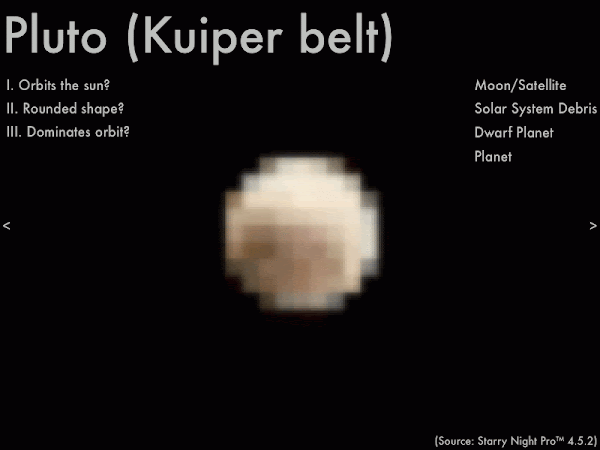 More recently, Pluto has been demoted from its planet status. Many people are not happy about this.
More recently, Pluto has been demoted from its planet status. Many people are not happy about this. And apparently neither is Pluto.
And apparently neither is Pluto. In this presentation we will go over the basis for classifying planets (and non-planets) in the solar system, which you will apply in the subsequent in-class activity.
In this presentation we will go over the basis for classifying planets (and non-planets) in the solar system, which you will apply in the subsequent in-class activity. First, the original and then the most recent definitions for planets.
First, the original and then the most recent definitions for planets.Recall that Greeks referred to "wanderers" making prograde/retrograde loops in the night sky as "planets," as observed over many nights. There were five planets visible to the naked eye back then: Mercury, Venus, Mars, Jupiter, and Saturn. (Why wasn't Earth considered a planet back then?) Subsequent re-definitions over time would result in more or fewer numbers of planets, which will be discussed in the in-class activity.
The most recent classification scheme was adopted by the International Astronomical Union in 2006, and can be considered a list of three questions to be answered either "yes" or "no" for a solar system object. At any point a question is answered "no," then the object is immediately classified, but if all three questions are answered "yes," then the object is classified as a planet.
First question: does the object orbit the sun directly? If "no" because it is orbiting something else orbiting the sun, then the object is classified as a moon or satellite. If "yes" to orbiting the sun directly, then the object proceeds to the second question.
Second question: does the object have a rounded shape, that is, was there enough mass such that it retained enough formation heat to melt itself, and enough gravity to form itself into a rounded shape? If "no" because it has a "lumpy potato" shape because it didn't have enough heat and gravity to round itself out, then the object is classified as solar system debris. If "yes" to having a rounded shape, then the object proceeds to the third and final question.
Third question: does the object dominate its orbit, that is, does it have enough mass compared to everything else in its vicinity to pull in or eject all other objects that share or cross its orbit? If "no" because it shares its orbit with many other similar objects, then the object is classified as a dwarf planet. If "yes" to dominating its orbit, then the object is classified as a planet.
 Second, let's apply the IAU classification scheme to various solar system objects.
Second, let's apply the IAU classification scheme to various solar system objects. Earth's moon, which we'll rotate to get a better sense of its shape. Does it orbit the sun? Does it have a rounded shape? Does it dominate its orbit? Based on the answers to these three questions, the moon must be classified as a __________.
Ceres (located in the asteroid belt), which we'll rotate to get a better sense of its shape. Does it orbit the sun? Does it have a rounded shape? Does it dominate its orbit? Based on the answers to these three questions, Ceres must be classified as a __________.
Toutatis (also located in the asteroid belt), which we'll rotate to get a better sense of its shape. Does it orbit the sun? Does it have a rounded shape? Does it dominate its orbit? Based on the answers to these three questions, Toutatis must be classified as a __________.
Mars, which we'll rotate to get a better sense of its shape. Does it orbit the sun? Does it have a rounded shape? Does it dominate its orbit? Based on the answers to these three questions, Mars must be classified as a __________.
Amalthea (in orbit around Jupiter), which we'll rotate to get a better sense of its shape. Does it orbit the sun? Does it have a rounded shape? Does it dominate its orbit? Based on the answers to these three questions, Amalthea must be classified as a __________.
Pluto (located in the Kuiper belt), which we'll rotate to get a better sense of its shape. (This simulation represents the limits of resolvability, even with the best telescopes.) Does it orbit the sun? Does it have a rounded shape? Does it dominate its orbit? Based on the answers to these three questions, Pluto must be classified as a __________.
 Although Mercury is classified as a planet, we include it here for comparison to the five known dwarf planets: Pluto, Eris (also in the Kuiper belt), Ceres, Haumea (which is somewhat flattened out due to its rapid rotation, but still "round enough"), and Makemake, the last two also in the Kuiper belt. (Why is Mercury a planet instead of a dwarf planet?) There may be twelve to twenty other asteroids and Kuiper belt objects that would be sufficiently round enough to be considered dwarf planets, but their true shapes have not yet been determined.
Although Mercury is classified as a planet, we include it here for comparison to the five known dwarf planets: Pluto, Eris (also in the Kuiper belt), Ceres, Haumea (which is somewhat flattened out due to its rapid rotation, but still "round enough"), and Makemake, the last two also in the Kuiper belt. (Why is Mercury a planet instead of a dwarf planet?) There may be twelve to twenty other asteroids and Kuiper belt objects that would be sufficiently round enough to be considered dwarf planets, but their true shapes have not yet been determined. In the subsequent in-class activity you will discuss the history of planetary classification schemes, and implement the current International Astronomical Union classification scheme to categorize different solar system bodies.









No comments:
Post a Comment